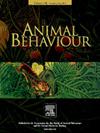揭示交流复杂性:两种不同社会系统狐猴的多模态比较研究
IF 2.3
2区 生物学
Q2 BEHAVIORAL SCIENCES
引用次数: 0
摘要
“交际复杂性的社会复杂性假说”(SCHCC)认为,更大的社会复杂性促进了更大的交际复杂性。这是因为在具有差异化社会互动的较大社会群体中,不确定性增加,这为更多样化和更灵活的信号提供了优势,以传递不同的信息并管理他人的行为。在这项研究中,我们提供了一个全面的方法来比较两种密切相关的真狐猴物种的多模态交流系统,它们具有相似的形态和生态,但不同的社会制度。在Kirindy和Ankatsabe森林分别采集了13只野生成年红额狐猴(Eulemur rufifrons)和10只野生成年猫鼬狐猴(E. mongoz)的行为学和声学数据,分别属于3个不同的类群。我们描述了一个新的分析框架,以评估信号系统的复杂性跨模式。应用多模态方法可能有助于揭示作用于交际系统的不同选择压力,并更好地理解从其组成部分的孤立研究中可能不明显的自适应功能。研究结果支持了猕猴桃具有比蒙古猕猴桃更复杂的社会系统的预测。与E. mongoz相比,E. rufifrons表现出更大的信号库、更高的信号率、更多的信号组合数量和更低的信号网络可预测性。我们讨论了这两个物种的交流系统的差异和与非同源信号相关的势函数。我们进一步在交流系统水平上探索潜在的进化途径,并在跨分类尺度上讨论所提出的框架的优势和局限性。本文章由计算机程序翻译,如有差异,请以英文原文为准。
Unravelling communicative complexity: a multimodal comparative study of two lemur species with different social systems
The ‘social complexity hypothesis for communicative complexity’ (SCHCC) suggests that greater social complexity promotes greater communicative complexity. This is because there is increased uncertainty in larger social groups with differentiated social interactions, providing an advantage for more diverse and more flexible signals to transfer diverse messages and to manage the behaviour of others. In this study, we offer a comprehensive approach to contrast the multimodal communicative systems of two closely related true lemur species having similar morphology and ecology but different social systems. We collected behavioural and acoustic data on 13 wild adult red-fronted lemurs, Eulemur rufifrons, belonging to three different groups, and 10 wild adult mongoose lemurs, E. mongoz, belonging to four different groups, in the Kirindy and Ankatsabe forests, respectively. We describe a new analytical framework to assess the complexity of signalling systems across modalities. Applying a multimodal approach may help uncover the different selective pressures acting on the communicative system and better understand adaptive functions that might not be obvious from the isolated study of its components. The results support the prediction of a more complex communicative system in E. rufifrons, which has a more complex social system than E. mongoz. E. rufifrons exhibited larger signalling repertoires, greater signalling rates, a greater number of signal combinations and a significantly lower level of predictability in its signalling network compared to E. mongoz. We discuss the differences in the communicative systems of the two species and the potential functions associated with nonhomologous signals. We further explore potential evolutionary pathways at the communicative system level and discuss the proposed framework’s advantages and limitations at a cross-taxonomic scale.
求助全文
通过发布文献求助,成功后即可免费获取论文全文。
去求助
来源期刊

Animal Behaviour
生物-动物学
CiteScore
4.60
自引率
8.00%
发文量
236
审稿时长
10.2 weeks
期刊介绍:
Growing interest in behavioural biology and the international reputation of Animal Behaviour prompted an expansion to monthly publication in 1989. Animal Behaviour continues to be the journal of choice for biologists, ethologists, psychologists, physiologists, and veterinarians with an interest in the subject.
 求助内容:
求助内容: 应助结果提醒方式:
应助结果提醒方式:


